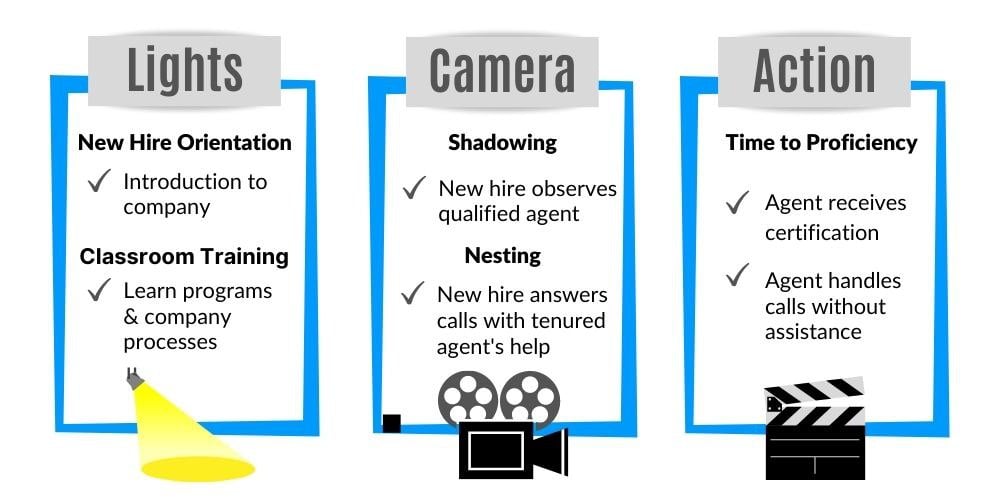The True Cost of Training a New Agent in the Call Center
It’s no secret — training isn’t cheap. Training new call center agents can be both time-consuming and expensive.
Hiring and training new agents is unavoidable with job turnover, company growth, and a need to have resources available to customers. In the end, we all know, new employees are a worthwhile investment.
So how much is your company spending on training new employees? Measuring the cost of your training program helps you know where you are currently at as a company. Then you will be able to compare the results and set goals for improvement.
Just like Michael Phelps always worked towards slimming another millisecond off his Olympic swimming records, you can have the same attention to detail for the effectiveness of your training program. As a training program, knowing your costs and making changes to your program can take you from swimming in the kiddie pool to competing amongst the elite swimmers. After all, we are looking for ways to be both time and cost efficient.
Calculate the efficiency of your call center training process with a simple equation:

Before calculating the true cost of training a new call center employee, there are key investment costs you need to gather first:
- Average number of days spent by new agents in classroom training, nesting, and shadowing
- Average number of days AFTER nesting and shadowing before an agent becomes fully proficient in the call center
- Average daily salary for a new agent
- Average daily salary for your training staff
- Cost of training systems
For a better understanding of the true cost of training new agents in a call center, follow these detailed steps and explanations to piece the equation for a more accurate calculation.
Average Length and Time of a New Hire in Training
With company systems, procedures, and sensitive information being shared in call centers, you don’t want to toss your new hires in the proverbial pool and hope they can swim. Even a doggy paddle isn’t sufficient for a call center employee, which is why the training process is often lengthy.

Thoroughly training new hires can take months. In fact, many call centers tell us that their average time to proficiency is 4-6 months. During this training period, those agents are pulling resources from the company instead of contributing to it.
What accounts for call center training time? The training process for call centers involves multiple phases:
- New Hire Orientation
- Classroom Training
- Shadowing
- Nesting
- Time to Proficiency
New Hire Orientation
During new hire orientation, employees are introduced to the company's general mission. Often, orientation is dedicated to taking care of HR documents. This doesn’t typically last longer than a few hours or a day.
Classroom Training
Depending on your business, classroom training can last merely days or up to months. Classroom training is dedicated to providing the base knowledge for the job. This often involves new agents memorizing rules and regulations of the company as well as processes. With an emphasis on memorization, new hires are often given quizzes to ensure they are retaining the extensive information.
🔎 Related: Save time training with Zero Memorization
Shadowing
After classroom training, new hires spend time watching experienced agents take real calls. This is an observation period. The time spent in the shadowing phase varies from company to company.

Nesting
The nesting phase of the training process is where new hires apply what they learned during the classroom training and shadowing phases. This is the hands-on, lower-risk experience. New hires take the calls while a trainer, or more experienced agent, is beside them to help the new hire in case they need assistance.
Time to Proficiency
Wouldn’t it be nice if new employees came trained? Of course! But the reality is that it takes time for new hires to learn the company’s systems and procedures to the point they can work independently and proficiently.
🔎 Related: What is time to proficiency and how does it affect your call center?
The Time to Proficiency can take up to months following training programs to reach the point that your agents are confident taking calls 100 percent on their own. A proficient worker doesn’t need to put a caller on hold to do further research or ask a superior a question.
In other words, your training process is a movie set for your business; it is a “Lights, Camera, Action” scenario.
In new hire orientation and classroom training, we are shedding light on the job responsibilities and expectations. As we move new agents into shadowing and nesting, we roll the camera on real-life, on-the-job experiences. Finally, we call for “Action” when we set new hires out on their own to answer calls. It takes time until they are proficient, but they are now in the trial and error aspect of the job as they become certified. Just as actors need direction on set, these new hires will need guidance from their supervisors as they acclimate to the company’s processes.
Average daily salary for a new agent
Taking into consideration the many steps in the training process, calculate the cost of the new hire:

Average daily salary for your training staff
In order to train new employees, it requires most companies to enlist the help of current call center agents — often the top agents since you want your new hires to learn from the best.
That means throughout the entire training process — from new hire orientation until the new hire reaches proficiency — there is at least one proficient employee’s salary being paid to train the new hires. This also means those productive employees are pulled off the phones and the workload is shifted.
Evaluate each of the steps of the training process and identify:
- How many current employees it takes to train a new employee
- Average pay of employees
- Time spent training new hires

Keep in mind, while new hire orientations often happen in large groups of new hires, steps like shadowing and nesting often require one-on-one attention, meaning more employees. Calculate accordingly.
📽️ Watch Related: How will trainers be able to do their jobs better with ScreenSteps?
Cost of Training Systems
Whether you use an outside training system or have specific training programs developed by your in-house HR Department, the software for training is part of your training expenses for new employees.
The total cost is your annual subscription and license costs to use the training technology, and/or the IT support needed to sustain the software in-house.

How much does it cost to train a call center agent?
New hire classes can be daunting. With any new hire class comes the typical concerns: How many will make it through training? How many will stay with the company long enough to make training them worth it?
Calculate the efficiency of your call center training process with a simple equation:

Or, if you’ve been following along through this article, find the sum of the total from the above equations.

Next Steps
Once you know how much you are spending on training new agents, it’s time for the next step: comparing training programs. This means calculating ROI (Return on Investment).
By measuring the ROI, you better understand the effectiveness of your training. The formula for calculating ROI is:
ROI = Investment Gain / Investment Base
Investing in a knowledge management and performance system (like ScreenSteps) can help you decrease the time it takes to make a new agent proficient. For example, we have worked with customers to decrease their Time to Proficiency from 60 days down to as little as 6.
🔎 Related: How to measure the ROI of ScreenSteps in your call center
Remember: The longer a new hire needs assistance from a trainer, the longer it costs your company twice the amount to complete one job. Spend less time double paying with ScreenSteps.
Conclusion
And as the old saying goes, time is money. Hopefully, this article has helped you evaluate where your company is when it comes to training new call center agents and, more importantly, can help you speed up the process and reach your training goals.
If you are looking to optimize your training program and shorten your new agents Time to Proficiency, see how ScreenSteps can help you reach your goals here. Or, if you would like to get in touch with our team to get some additional insights into how you can decrease your Time to Proficiency, just contact us here.
Keep on track with these call center guides and tips:
- What is Time to Proficiency?
- What is Zero Memorization Training?
- How will my call center reps use ScreenSteps?





